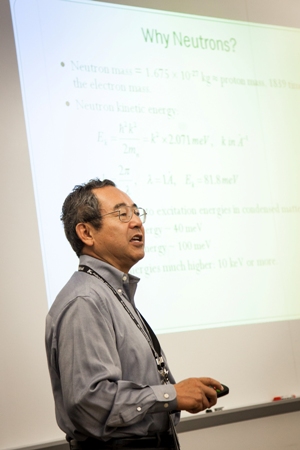Nov 27 2012
Neutron scattering is a specialized tool that allows scientists to do breakthrough research into the nature of advanced materials.
 The University of Tennessee Takeshi Egami is among the cybercourse instructors.
The University of Tennessee Takeshi Egami is among the cybercourse instructors.
Developing expertise in neutron scattering can be difficult, however, because the field is too narrow to merit an entire graduate course but too deep to learn by reading a textbook, said University of Tennessee neutron scientist Takeshi Egami.
To address the problem, the Department of Energy's Oak Ridge National Laboratory organized interactive, streamed lectures involving UT and five other universities and is offering them free online. The lecture series has attracted online students worldwide and remains available to those who register.
"Neutron Scattering in Quantum Condensed Matter Physics" consists of 26 lectures given in the 2012 fall semester. The cybercourse began in early September and finishes early in December. The 75-minute lectures have been presented twice each week.
Centrally coordinated by the Neutron Sciences Directorate (NScD) and the Joint Institute for Neutron Science (JINS) at ORNL, the course is taught by neutron scattering researchers Collin Broholm (Johns Hopkins University), Takeshi Egami (University of Tennessee), Young S. Lee (Massachusetts Institute of Technology), Seunghun Lee (University of Virginia), Stephen Nagler (ORNL), Roger Pynn (Indiana University), and Sunil K. Sinha (University of California-San Diego).
The course was developed by Meiyun Chang-Smith, education manager for NScD and JINS. It is apparently the first time researchers from several prestigious institutions in the U.S. have collaborated to provide a neutron scattering course online.
Class topics included the theory of inelastic and elastic neutron scattering, magnetic neutron scattering, neutron sources and instrumentation, surfaces and interfaces, phonons, magnetic excitations, and critical phenomena. It was open to advanced Ph.D. students, postdoctoral researchers, and faculty members who want to learn more about neutron scattering as a tool for research in the structure and dynamics of condensed matter.
The lectures are transmitted live from the home university of the lecturer using the Adobe Connect interactive software platform, and they're recorded with a webcam. PowerPoint slides and a live cyber whiteboard feature enable the lecturer to give both the onsite and remote audiences detailed explanations.
Online registrants get a username and password to log in to use the resources on the web site. They also get a URL link for logging in to the live lectures. An interactive feature on Adobe Connect allows participants -- from wherever they are — to ask questions and make comments during the live lecture via a chat box. Homework assignments are posted and, subsequently, correct answers.
A number of students enrolled for credit at their respective schools, and launching the course to the neutron community nationally and abroad has boosted numbers to 149 to date.